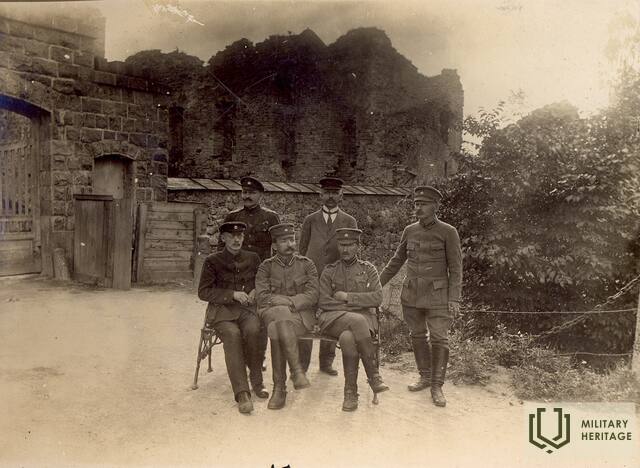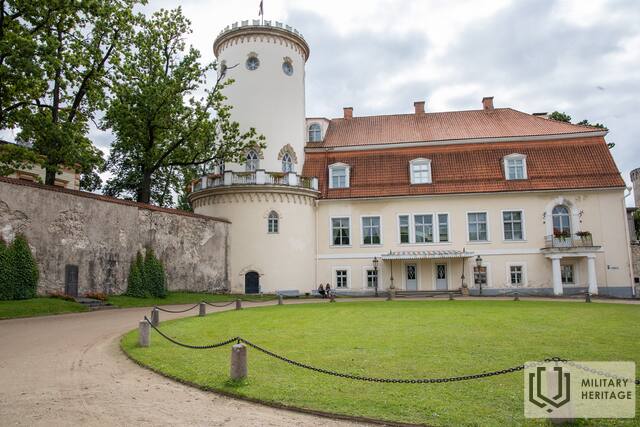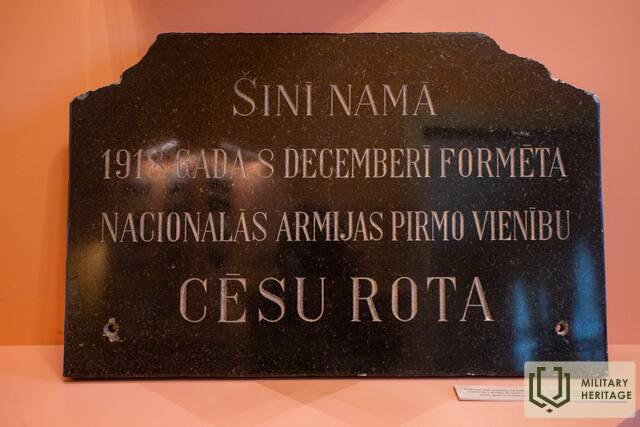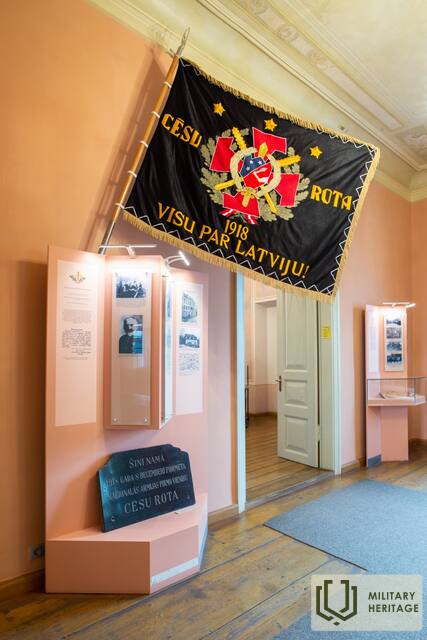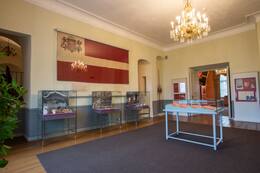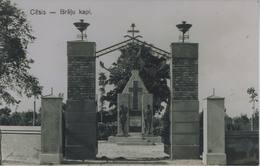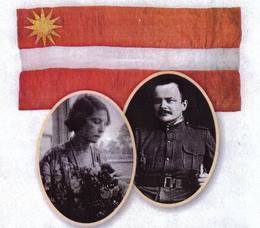Cėsių Naujoji pilis – sienos, sukūrusios Latvijos valstybės saugumą ir tebesaugančios asmens dokumentus
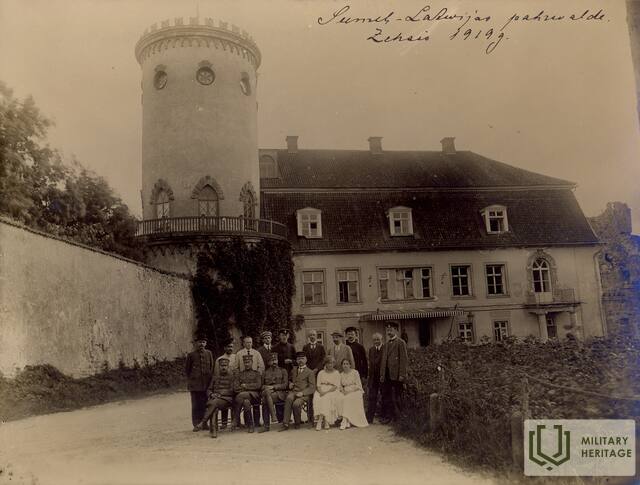
Cėsių Naujoji pilis pastatyta ant karinio įtvirtinimo – viduramžių pilies – griuvėsių. Tačiau tai ne vienintelė pastato karinė reikšmė.
Graži grafų Sieversų rezidencija ne tik užtikrino jos savininkų ir statytojų saugumą ir gerovę, bet ir tapo pirmųjų Latvijos ginkluotųjų pajėgų formuočių gimimu jos sienose. 1918 m. gruodžio 8 d. joje susikūrė Cėsių kuopa, kuri dalyvavo pirmuosiuose Latvijos išsivadavimo karo mūšiuose. Tai ankstyviausios kautynės, už kurias keli dalyviai buvo apdovanoti Lāčplės karo ordinu. Vėliau kuopa buvo įtraukta į vadinamąjį Kalpako batalioną, kovojusį už Latvijos išlaisvinimą Kuršoje 1919 m.
1919 m. Cėsių Naujoji pilis tarnavo kaip Latvijos laikinosios Kārlio Ulmanio vyriausybės prieglobstis – pilyje veikė tik Šiaurės Latvijos civilinė administracija. Tai laikas, kai Cėsių miestas trims dienoms įgyja sostinės svarbą.
Nuo 1949 metų Cėsių istorijos ir meno muziejaus surinkti istorijos liudininkai saugų prieglobstį rado Cėsių Naujosios pilies sienose. Studentų sąjungos „Līdums“ dėka Cėsių muziejus nuo 1933 m. yra svarbus Latvijos vėliavos istorijos saugotojas. Muziejaus darbuotojai ne tik kruopščiai saugojo šiuos vertingus mūsų šaliai liudijimus, bet ir buvo pakankamai drąsūs, kad apsaugotų juos nuo sunaikinimo sovietinės okupacijos metais: netrukus po Antrojo pasaulinio karo pabaigos, Cėsis Berkholce muziejaus mokslinėje veikloje dalyvavo muziejaus muziejuje kolekciją. Sunaikinti skirtas medžiagas ji parsineša namo ir pasilieka. 1997 metais ji juos grąžino muziejui.
Latvijai atgavus nepriklausomybę muziejaus darbuotojai nuolat tyrinėja ir populiarina vėliavos istoriją. 2000 m. pas skaitytojus atvyko muziejaus istorikas dr.hist. Didelis Tālis Pumpuriņas darbas, sukauptas jo knygoje "Raudona, balta ir raudona – Latvijos vėliavos spalvos. Latvijos nacionalinės vėliavos istorijos tyrimai, prisiminimai, dokumentai", Nuo 2012 m. muziejaus ekspozicijoje vėliavos istorijai skirta speciali patalpa – Vėliavos salė, kurioje saugoma ir pirmoji Janio Lapiņšo sukurta Latvijos nacionalinė vėliava. 2016-ieji tuo ypatingi, nes sukanka 100 metų nuo vėliavos sukūrimo.
Cėsių istorijos ir meno muziejus, 2016 11 09
Susijusios temos
Susijusios vietos
Cėsių istorijos ir meno muziejus Cėsių Naujojoje pilyje
Cėsių istorijos ir meno muziejus yra įsikūręs pačiame Cėsių senamiesčio centre, Naujojoje pilyje. Muziejuje veikia nuolatinė istorijos ir interjero ekspozicija „Cėsys – Latvijos istorijos simbolis“, kurią sudaro du teminiai skyriai: ekspozicija „Raudona-balta-raudona vėliava Cėsių ir Latvijos istorijoje“ aiškina Latvijos nacionalinės vėliavos istoriją nuo XIII iki XX a., patvirtintą nacionalinį simbolį, Latvijos šaulių batalionų vėliavas ir nacionalinių spalvų naudojimo tradicijas Latvijos nepriklausomybės karo metu. Parodoje „Cėsys ir Latvijos nepriklausomybės karas“ daugiausia dėmesio skiriama Cėsių kuopos įkūrimui 1918 m. gruodžio mėn., bendroms estų ir latvių kovos pastangoms 1919 m. Cėsių mūšiuose, laikui, kai Bermonto aferos metu Cėsys trumpą laiką buvo laikinoji Latvijos sostinė, taip pat Cėsių pergalės paminklo istorijai. Pabėgimo kambaryje „Cėsių mūšių legendos“ dalyviai turi valandą rasti išeitį spręsdami galvosūkius, užmegzdami ryšius ir ieškodami paslėptų daiktų. Cėsių kuopa, vienas pirmųjų Latvijos ginkluotųjų pajėgų dalinių, buvo įkurta 1918 m. gruodžio 8 d. Cėsių pilyje vyresniojo leitenanto Artūrs Jansons. Muziejaus ekspozicijoje eksponuojama Cėsių kuopai skirta atminimo lenta, atidengta 1933 m. gruodžio 8 d. Cėsių Naujojoje pilyje, kuri tuo metu buvo 8-ojo Daugpilio pėstininkų pulko ir garnizono karininkų klubo štabas.
Cėsių brolių kapinės
Įsikūręs Cėsių Žemutinėse kapinėse, Lenču g. 15, Cėsis.
Viena reikšmingiausių Pirmojo pasaulinio karo ir Nepriklausomybės kovų memorialinių vietų Cėsyje yra Brolių kapinės Lejos Kapuose.
Kapinėse yra Cėsių menininko ir tarybos nario Augusto Jullos (1872–1958) suprojektuotas, 1927 m. atidengtas Brolių kapinių paminklas, skirtas 1915–1920 m. Brolių kapinėse palaidotiems kariams.
Cėsių Žemutinių kapinių Brolių kapuose palaidota apie 200 kareivių. Tarp jų yra nežinomas skaičius Latvijos šaulių ir rusų kareivių, žuvusių Pirmajame pasauliniame kare, taip pat vokiečių (10), lenkų ir kitų tautybių kareivių. Latvijos išsivadavimo kovų metu šiose kapinėse palaidoti 22 5-ojo (2-ojo) Cėsių pėstininkų pulko kareiviai, taip pat 11 laisvės kovotojų, žuvusių kituose Latvijos armijos daliniuose. Brolių kapuose taip pat ilsisi 2 estai, 15 bolševikų aukų ir Latvijos raudonieji šauliai.
Memorial place of J. Lapiņš, the author of the first flag of Latvia
It is located in "Lejas Pintuli", Veselava parish, Priekuļi district.
A memorial to Jānis Lapiņas, the author of the pre-flag of Latvia, can be seen.
The Latvian national flag was created during the First World War. In 1915, when creating the flags of the Latvian rifle battalions, some artists offered red and white colors to the flag throwers. In the second half of 1916, the red-and-white flag thrown by the pedagogue and journalist Jānis Lapiņa was made by his student, Marianna Straumane, a teacher at the refugee shelter in Valmiera.
It is the first known and actually made Latvian national flag, which has survived to our days.
In 2014, a memorial to Jānis Lapiņas, the author of the pre-flag, was opened in "Lejas Pintuulis" of Veselava Parish, Priekuļi County.
The first known authentic Latvian national flag, which passed through the refugee corridors in Russia, was carefully hidden during the Soviet and German occupation, and is currently kept in the Cēsis Museum of History and Art . It was given as a gift in 1997 by their daughter Lija Poga.




